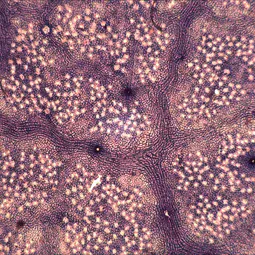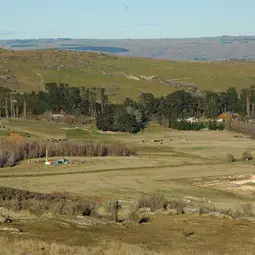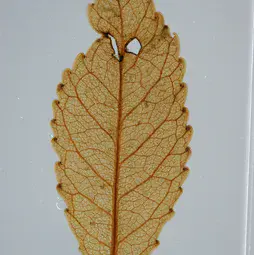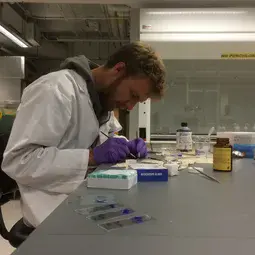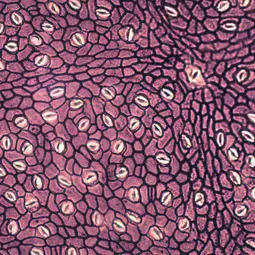Fossil leaves point to global greening in the coming decades
20 August 2020
Scientists studying fossil leaves from an ancient Southern Hemisphere rainforest have, for the first time, measured how plants in that location responded to living in a world with elevated levels of atmospheric carbon dioxide. The results, published this week in the European Geosciences Union (EGU) journal Climate of the Past, indicate potential parallels with modern-day increases in carbon dioxide that could soon lead to a global “greening” effect in addition to rising sea levels, more severe weather, and other consequences of climate change.
The researchers discovered the fossil leaves in an ancient lake bed at Foulden Maar, an extinct volcanic crater near the city of Dunedin on New Zealand’s South Island. The crater, which formed during the early Miocene 23 million years ago, hosted a lake that slowly filled in and, in the process, preserved the remains of the vibrant subtropical rainforest growing there.
Previous research has indicated that elevated carbon dioxide levels led to warmer temperatures during the Miocene, and that certain plants were able to use water more efficiently under those conditions. This study is the first to measure this theoretical increase in water-use efficiency, and the results provide empirical evidence of a carbon dioxide fertilisation effect in the fossil record.
Mummifed fossils
The site’s tens of thousands of fossils, which include fish, spiders, sucking bugs and hundreds of other insects as well as dozens of plant species, are exquisitely preserved thanks to their being layered between the hard remains of silica-rich algae. “Because the leaves at Foulden Maar are mummified, the site presents a very rare opportunity to make anatomical and chemical measurements on the leaves that translate directly to climatic and atmospheric conditions at the time the forest was growing,” says the study’s lead author Tammo Reichgelt, a paleobotanist at the University of Connecticut and Columbia University’s Lamont-Doherty Earth Observatory.
The fossils at Foulden Maar date from a time when global temperatures were on average about 5-6 degrees Celsius higher than today and as much as 8 degrees Celsius warmer in southern New Zealand. ”Our results suggest that during the time when the rainforest around Foulden Maar existed, the amount of carbon dioxide in the air was between 450 and 550 parts per million,” says Reichgelt. “For comparison, the current atmospheric carbon dioxide concentration is 411 parts per million, and is projected to reach 500 by about 2040.” By that time, massive damage to coral reefs, more severe wildfires, and flooded coastlines are predicted if our current rate of greenhouse gas emissions continue, according to a 2018 special report by the Intergovernmental Panel on Climate Change.
A model for the future
The study’s findings indicate that the trees growing around Foulden Maar functioned very differently from trees today. “Surprisingly, the trees that grew in these higher carbon dioxide conditions 23 million years ago appear to have been as good as, or better, at conserving water than a modern-day tree in much more water-stressed environments, such as the Mediterranean,” Reichgelt says.
Studying the response of plants from Foulden Maar can therefore provide researchers with a model for what changes in plant function might need to look like for some species in the future. All plants must lose water to take up carbon dioxide through their pores, according to Reichgelt, but as the levels of atmospheric carbon dioxide increase, some species are better at recalibrating so that they lose less water during this process. “What this means,” he says, “is that some plants can effectively become more drought tolerant and therefore benefit more than others.”
Given enough time for plants to adapt, says Reichgelt, this increased tolerance may lead to an expansion of Earth’s forests, but the current speed of change makes it difficult for biota to adapt. In addition, he says, it’s hard to predict the future winners and losers, especially because Earth’s atmospheric carbon dioxide concentrations are changing at a much faster rate than during the Miocene. “Shifting habitats and other changes, whether due to temperature or due to increased drought tolerance, puts stress on plants,” he says, “especially those that require stability, such as long-lived trees.” Most studies say that the net effect of warming, changes in precipitation, and additional carbon dioxide are not beneficial for ecosystems on a global level. It’s also not yet clear how long the fertilisation effect lasts; satellite-derived evidence suggests that it may diminish over time.
World-class fossil site
This and other recently published studies based on the Foulden Maar fossils highlight the potential knowledge still to be gained from this site, whose importance activists have compared to the UNESCO-listed Messel Pit Fossil Site in Germany. The New Zealand locale came close to being quarried as an additive for pig food before scientists and locals rallied to save it.
“To palaeoclimatologists, Foulden Maar is like an undisturbed Egyptian burial tomb that has just been unlocked,” says Reichgelt. “We’ve only just started deciphering the hieroglyphs.” The major difference, he says, is that at Foulden Maar, the “tomb” is 23 million years old, and it records the history from a period in Earth’s history that lasted 100,000 years. “This site still has much to reveal about the climate from a time with elevated carbon dioxide,” he says.
###
When reporting on this story, please mention the name of the publication Climate of the Past, and, if reporting online, include a link to the paper: https://doi.org/10.5194/cp-16-1509-2020 or to the journal website: https://www.climate-of-the-past.net/.
More information
Citation: Reichgelt, T., D’Andrea, W. J., Valdivia-McCarthy, A. d. C., Fox, B. R. S., Bannister, J. M., Conran, J. G., Lee, W. G., and Lee, D. E.: Elevated CO2, increased leaf-level productivity, and water-use efficiency during the early Miocene, Clim. Past, 16, 1509–1521, https://doi.org/10.5194/cp-16-1509-2020, 2020.
All EGU journal articles are open access.
Climate of the Past is a not-for-profit international scientific journal dedicated to the publication and discussion of research articles, short communications, and review papers on the climate history of the Earth.
Contact
Researchers
Tammo Reichgelt
Department of Geosciences, University of Connecticut
Lamont-Doherty Earth Observatory, Columbia University
Email tammo.reichgelt@uconn.edu
Daphne Lee
Department of Geology, University of Otago
Email daphne.lee@otago.ac.nz
Phone + 64 467 9303 or +64 021 100 8926
Press officer
Terri Cook
European Geosciences Union
Munich, Germany
Email media@egu.eu

